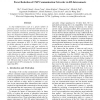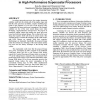989 search results - page 55 / 198 » Dynamic Symmetry Reduction |
FPGA
2010
ACM
14 years 6 months ago
2010
ACM
Guarded evaluation is a power reduction technique that involves identifying sub-circuits (within a larger circuit) whose inputs can be held constant (guarded) at specific times d...
ICCAD
2005
IEEE
14 years 6 months ago
2005
IEEE
— Although the LUT (look-up table) size of FPGAs has been optimized for general applications, complicated designs may contain a large number of cascaded LUTs between flip-flops...
MICRO
2008
IEEE
14 years 4 months ago
2008
IEEE
As chip multiprocessors scale to a greater number of processing cores, on-chip interconnection networks will experience dramatic increases in both bandwidth demand and power dissi...
ICS
1998
Tsinghua U.
14 years 2 months ago
1998
Tsinghua U.
In order to achieve high performance, contemporary microprocessors must effectively process the four major instruction types: ALU, branch, load, and store instructions. This paper...
CF
2005
ACM
13 years 12 months ago
2005
ACM
In modern superscalar processors, the complex instruction scheduler could form the critical path of the pipeline stages and limit the clock cycle time. In addition, complex schedu...



